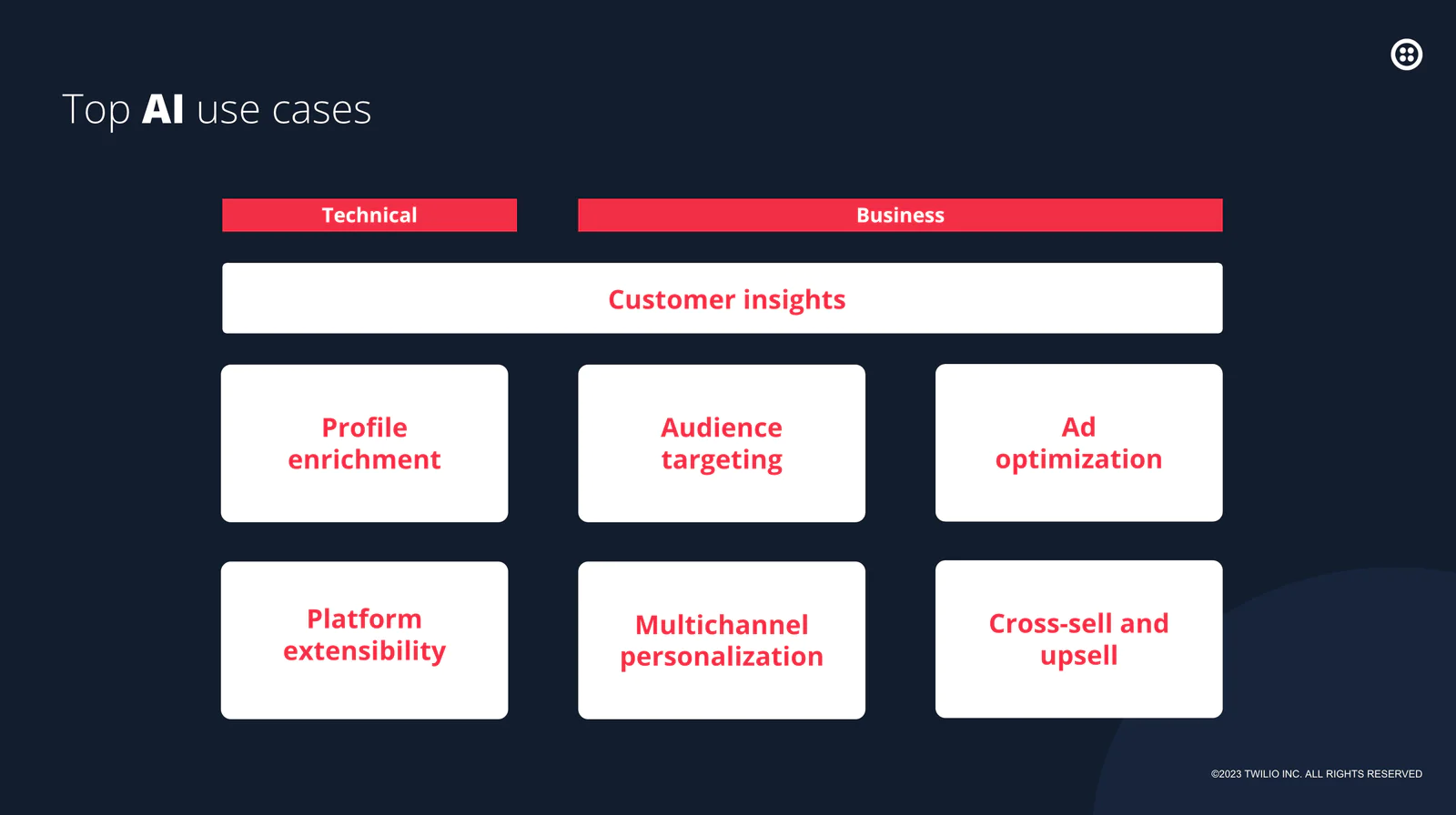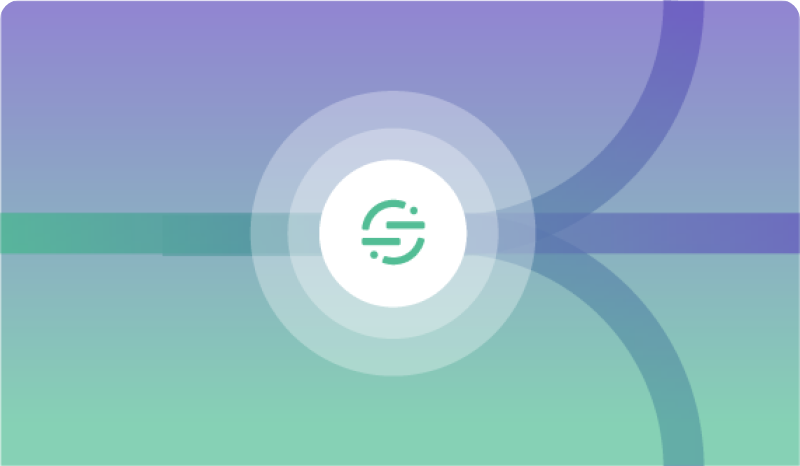Building the future of customer experiences with data, communications, and AI
Twilio Segment’s new predictive and generative AI releases help technical and business teams improve productivity, personalization, and performance.
Twilio Segment’s new predictive and generative AI releases help technical and business teams improve productivity, personalization, and performance.
Now generally available, AI Recommendations and enhancements to AI Predictions make it easier than ever for marketers to identify, target, and personalize experiences for greater ROI
New generative AI features help both marketers and developers improve productivity and speed time to value
Generative AI has the potential to fundamentally change the way everyday people work, live, and communicate.
For businesses and consumers, it’s the outcomes, not the myriad stories and social posts, that matter most.
Your customers don’t care what large language model (LLM) you use to serve them. They care that they received a relevant, trusted, personalized experience that resonates with them.
These are the experiences that drive growth, loyalty, and customer satisfaction — which is the ultimate goal for most businesses.
Many businesses are now looking to AI as a faster and easier way to deliver these personalized experiences at scale. But AI often lacks the important context and relevance needed to ensure the most accurate outputs.
Creating completely individualized and omnichannel customer experiences requires a deep understanding of who every customer is, what they want in that moment, and a reliable and effective way to engage them at scale.
Yet most companies struggle to get the complete, consistent, and real-time data they need to truly know their customers. Our recent State of Customer Engagement Report revealed that only 16% of brands strongly agree that they have the data they need to understand their customers.
Think about it. If a customer views ads on Facebook, makes a purchase on your website, then signs up for a loyalty program, and later on has a customer support conversation, all of those actions are likely being captured on individual systems. Often, these systems aren’t talking to each other, which makes it impossible to get a single view of your customer.
This is where customer data platforms (CDPs), like Twilio Segment, come into play.
Segment’s complete, extensible, and scalable CDP helps companies break down data silos across teams and tools — including the data warehouse — providing a single view of your customer across every channel and phase of the customer journey, no matter what your techstack looks like.
We make it easy for every team in your organization to activate these unified, identity-resolved, and real-time profiles (that include context from the data warehouse) everywhere your customers are. These unified profiles provide the essential foundation for AI-driven experiences that offer end-to-end personalization.
Twilio also has a vast amount of communications data that offers important context around who a person is and what their communications preferences are for even better AI- or human-led customer experiences.
Our rich set of data, coupled with our ability to learn from each customer interaction, creates a flywheel unique to Twilio — powering trillions of personalized and contextualized interactions.
The future of customer engagement is at this intersection of data, communications, and AI.
What if, with every interaction you had with a company, that business knew who you were, why you were engaging with them, and had not only predicted your needs, but could also seamlessly deliver the solution on your preferred channel in real time?
These are the types of intelligent interactions we’re committed to unlocking: delivering truly individualized experiences for consumers and driving better outcomes at a lower cost for businesses.
Today, we’re excited to announce our latest predictive and generative AI features, built to help both technical and non-technical teams work more efficiently.
With AI, technical teams can more quickly and easily collect data from every tool in their tech stack, and marketing teams can then use this unified data with user-friendly AI to better identify, target, and engage customers for improved productivity and campaign performance.
Predictions
When we launched AI Predictions last year, we put the power of predictive AI directly in marketers hands, so they could precisely target and personalize their customer experiences without needing to rely on data science teams.
This year, we’ve continued to make generally available improvements to this feature including:
More flexible time horizons
Ability to easily include or exclude specific events from the predictive model
Ability to predict on the event-property level (e.g likelihood to make a purchase over $100)
Increased frequency of our predictive score updates from weekly to daily updates
Business outcomes: Trade Me, New Zealand's largest online auction site, uses Predictions to rely less on their data science resources by empowering their marketing team to solve their own data challenges, leading to:
2-3x better paid ad campaign performance than other leading AI tools
20% increase in campaign open rates
10% increase in campaign click-through rates
Recommendations
With AI Recommendations, we’re making it easy for marketers to build audiences of people who are most likely to purchase a specific product, brand, or product category, so they can target those audiences in downstream channels, like ad platforms, or launch better multichannel customer journeys.
Now in general availability, Recommendations can help you quickly provide customers with more relevant experiences that improve conversions, boost upsell, and grow average order value.
Pretend you’re a marketer at a sportswear store that's looking to increase sales around the Olympics. With Recommendations, you could choose a specific category, like women’s running shoes, then automatically build an audience of people who are highly interested in purchasing those shoes — allowing you to design hyper-personalized offers and optimize your message for better engagement in ads, emails, SMS, or other preferred channels.
Business outcomes: One global retailer in a private beta test emailed customers who Segment recommended as the most likely to purchase Apple products and saw a 592% increase in sales per email.
Generative Audiences
Now generally available, AI Generative Audiences empowers marketers to create target audiences in minutes with a simple text prompt.
Instead of going through every stage of our audience builder in Twilio Engage, you can now describe the specific audience you want to build and Engage will automatically generate that audience for you. This helps marketers create complex audiences with unprecedented speed, ease, and scale.
Business outcomes: Our customers are already seeing a 3x improvement in the time it takes to build an audience with Generative Audiences.
Functions Co-Pilot
Now in public beta, Functions Co-Pilot is our first AI feature built specifically to help developers achieve faster time to value with Segment. It consists of two features:
Functions Writer, which generates code from natural language prompts, turning what would previously have been weeks of integration coding into a simple prompt that’s about the same length as a text message.
Functions Analyzer, which scans your existing code, summarizes what it does back to you, and then offers recommendations for how you can optimize the Function.
Current Functions customer: Start using this beta feature in-app today!
AI helps teams across your organization draw meaningful customer insights that can be key to optimizing every customer experience — from online and in-app experiences to onboarding and support interactions.

On the technical side, AI can help accelerate time to value by improving the extensibility of Segment CDP with generative AI that helps developers more quickly create custom integrations and launch new channels that extend what’s possible with your CDP.
Additionally, Predictions can enrich your customer profiles with propensity scores that can be used directly by data teams within Segment or your data warehouse of choice.
For business users, AI is putting no-code AI built on companies' own trusted data, directly into the hands of marketers for much more precise audience targeting — without needing to tap data teams.
Once you have those hyper-targeted audiences, you can easily activate them in ad platforms for greater return on ad spend (ROAS) with more intelligent lookalike campaigns and suppression lists. Better targeting also means better personalization not only in ads but also email, SMS, push notifications, web experiences, and more.
Plus, Recommendations is especially great at helping to boost upsell and cross-sell by letting you target the people primed for upgrades with the right content to drive complimentary purchases.
Endless use cases also means that the sky’s the limit for what metrics AI can help you boost.

Ready to start more cost-effectively and efficiently delivering personalized customer experiences at scale with AI?
Watch this short tutorial on how AI can help you boost upsell and cross-sell
Request a demo from one of our Segment experts

Our annual look at how attitudes, preferences, and experiences with personalization have evolved over the past year.